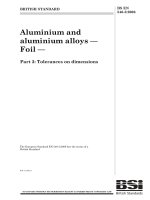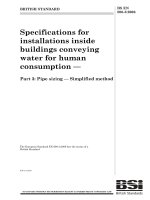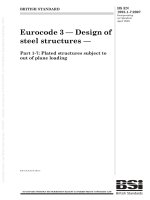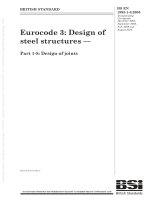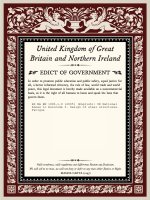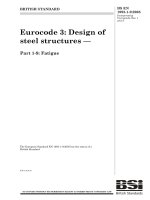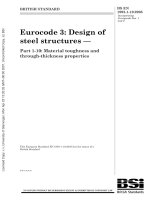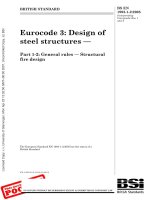Bsi bs en 01993 3 1 2006
Bạn đang xem bản rút gọn của tài liệu. Xem và tải ngay bản đầy đủ của tài liệu tại đây (2.62 MB, 82 trang )
Th
eEu
r
o
p
e
a
nUn
i
o
n
≠ EDI
CTOFGOVERNMENT±
I
no
r
d
e
rt
op
r
o
mo
t
ep
u
b
l
i
ce
d
u
c
a
t
i
o
na
n
dp
u
b
l
i
cs
a
f
e
t
y
,e
q
u
a
lj
u
s
t
i
c
ef
o
ra
l
l
,
ab
e
t
t
e
ri
n
f
o
r
me
dc
i
t
i
z
e
n
r
y
,t
h
er
u
l
eo
fl
a
w,wo
r
l
dt
r
a
d
ea
n
dwo
r
l
dp
e
a
c
e
,
t
h
i
sl
e
g
a
ld
o
c
u
me
n
ti
sh
e
r
e
b
yma
d
ea
v
a
i
l
a
b
l
eo
nan
o
n
c
o
mme
r
c
i
a
lb
a
s
i
s
,a
si
t
i
st
h
er
i
g
h
to
fa
l
lh
u
ma
n
st
ok
n
o
wa
n
ds
p
e
a
kt
h
el
a
wst
h
a
tg
o
v
e
r
nt
h
e
m.
EN 1993-3-1 (2006) (English): Eurocode 3: Design of steel
structures - Part 3-1: Towers, masts and chimneys – Towers
and masts [Authority: The European Union Per Regulation
305/2011, Directive 98/34/EC, Directive 2004/18/EC]
EUROPEAN STANDARD
EN 1993-3-1
NORME EUROPEENNE
EUROpAISCHE NORM
October 2006
Supersedes ENV 1993-3-1:1997
les 91.010.30; 91.080.10
Incorporating corrigendum July 2009
English Version
Eurocode 3 - Design of steel structures - Part 3-1: Towers,
masts and chimneys - Towers and masts
Eurocode 3 - Calcul des structures en acier - Partie 3-1:
Tours, mats et cheminees - Pyl6nes et mats haubannes
Eurocode 3 Bemessung und Konstruktion von
Stahlbauten - Teil 3-1: TOrme, Maste und Schornsteine TOrme und Maste
This European Standard was approved by CEN on 9 January 2006.
CEN members are bound to comply with the CEN/CENELEC Internal Regulations which stipulate the conditions for giving this European
Standard the status of a national standard without any alteration. Up-to-date lists and bibliographical references concerning such national
standards may be obtained on application to the Central Secretariat or to any CEN member.
This European Standard exists in three official versions (English, French, German). A version in any other language made by translation
under the responsibility of a CEN member into its own language and notified to the Central Secretariat has the same status as the official
versions.
CEN members are the national standards bodies of Austria, Belgium, Cyprus, Czech Republic, Denmark, Estonia, Finland, France,
Germany, Greece, Hungary, Iceland, Ireland, Italy, Latvia, Lithuania, Luxembourg, Malta, Netherlands, Norway, Poland, Portugal, Romania,
Slovakia, Slovenia, Spain, Sweden, Switzerland and United Kingdom.
EUROPEAN COMMITTEE FOR STANDARDIZATION
COMlTE EUROPEEN DE NORMALISATION
EUROpAISCHES KOMITEE FUR NORMUNG
Management Centre: rue de Stassart, 36
© 2006 CEN
All rights of exploitation in any form and by any means reserved
worldwide for CEN national Members.
B-1050 Brussels
Ref. No. EN 1993-3-1 :2006: .
B5 EN 1993-3~1 :2006
EN 1993-3-1 :2006 (E)
Contents
1
Gelleral ....................................................................................................................................................... 9
).1 Scope .................................................................................................................................................. 9
] .2 Nonnative references ......................................................................................................................... 9
1.3 ASSLllnptions ..................................................................................................................................... 10
1.4 Distinction between principles and application rules ....................................................................... 10
1.5 l'enns and definitions ....................................................................................................................... 10
1.6 Sylnbols ............................................................................................................................................ 11
1.7 Convention for cross section axes .................................................................................................... 12
2
Basis of desigll .......................................................................................................................................... 13
2.1 Requirenlents .................................................................................................................................... ) 3
2.2 Principles of limit state design ......................................................................................................... 14
2.3 Actions and environmental influences ............................................................................................. 14
2.4 Ultimate limit state verifications ...................................................................................................... ] 5
2.5
assisted by
................................................................................................................ 15
2.6 Durability ......................................................................................................................................... 15
3
Materials .................................................................................................................................................. 16
3. I Structural steel .................................................................................................................................. 16
3.2 Connections ...................................................................................................................................... 16
3.3 Guys and fittings .............................................................................................................................. 16
4
Durability ................................................................................................................................................. 16
4.1 Al10wance for corrosion ................................................................................................................... 16
4.2 Guys ................................................................................................................................................. 16
5
Structural allalysis ................................................................................................................................... 17
5.1 Modelling for determining action effects ......................................................................................... 17
5.2 Modelling of connections ................................................................................................................. 17
6
Ultimate lilllit states ................................................................................................................................ 18
6.1 General ............................................................................................................................................. 18
6.2 Resistance of cross sections ............................................................................................................. 18
6.3 Resistance of lnelnbers ..................................................................................................................... 18
6.4 Connections ...................................................................................................................................... 20
6.5 Special connections for masts .......................................................................................................... 21
7
Serviceability limit states ........................................................................................................................ 23
7.] Basis ................................................................................................................................................. 23
7.2 Deflections and rotations .................................................................................................................. 23
7.3 Vibrations ......................................................................................................................................... 23
8
Design assisted by testing ........................................................................................................................ 24
9
Fatigue ...................................................................................................................................................... 24
9.1 (ienera] ............................................................................................................................................. 24
9.2 Fatigue loading ................................................................................................................................. 24
9.3 Fatigue resistance ............................................................................................................................. 25
9.4 Safety assessnlent ............................................................................................................................. 25
9.5 Partial factors for fatigue .................................................................................................................. 25
9.6 F~atigl1e of guys ................................................................................................................................. 25
Annex A [nonnative] - Reliability differentiation and partial factors for actions ................................... 26
A. ] Reliability differentiation for masts and towers
2
85 EN 1993-3-1 :2006
EN 1993-3-1 :2006 (E)
A.2 Partial factors for actions .................................................................................................................. 26
Annex B [inforJllative] -lVlodelling of 11leteoroiogical actions ................................................................... 27
B.I (Jeneral ............................................................................................................................................. 27
B.2 Wind force ........................................................................................................................................ 28
B.3 Response of lattice to\vers ................................................................................................................ 40
B.4Response of guyed nlasts ................................................................................................................. 45
Annex C [inforJl1ative] - Ice loading and combinations of ice with wind .................................................. 53
C.l
C.2
C.3
C.4
C.5
C.6
(jeneral ............................................................................................................................................. 53
Ice loading ........................................................................................................................................ 53
Tce \veight ......................................................................................................................................... 54
Wind and ice .................................................................................................................................... 54
ASYlnnletric ice load ........................................................................................................................ 54
Combinations of ice and wind .......................................................................................................... 55
Annex D [nornlative] - Guys, dmupers, insulators, ancillaries and other items ......................................56
0.1
0.2
0.3
0.4
Guys ................................................................................................................................................. 56
Danlpers ........................................................................................................................................... 56
Insulators .......................................................................................................................................... 57
Ancillaries and other itelns ............................................................................................................... 57
Allllex E [illfornlative] - Guy rupture .......................................................................................................... 59
E.l
E.2
E.3
E.4
Introduction ...................................................................................................................................... 59
Silnplified analytical 1110del ............................................................................................................. 59
Conservative procedure .................................................................................................................... 60
Analysis after a guy rupture ............................................................................................................. 61
Annex F [inforJllative] - Executioll ............................................................................................................... 62
F.l
F.2
F.3
F.4
F.5
General ............................................................................................................................................. 62
Bolted connections ........................................................................................................................... 62
Welded connections ......................................................................................................................... 62
Tolerances ........................................................................................................................................ 62
Prestretching of guys ........................................................................................................................ 63
Annex G [informative] - Buckling of components of masts and towers .................................................... 64
G.I Buckling resistance of compression members ................................................................................. 64
G.2 Effective slenderness factor k .......................................................................................................... 64
Annex H
f-I.I
H.2
H.3
HA
H.5
[infonnative] Buckling length and slenderness of members ................................................... 70
(:Jeneral ............................................................................................................................................. 70
Leg Inelnbers .................................................................................................................................... 70
Bracing Inelnbers ............................................................................................................................. 71
Secondary bracing members ............................................................................................................ 78
Shell structures ................................................................................................................................. 79
3
BS EN 1993·3·1 :2006
EN 1993-3-1:2006 (E)
Foreword
This European Standard EN 1993-3-1, Eurocode 3: Design of steel structures: Part 3.1: Towers, masts and
chimneys
Towers and masts, has been prepared by Technical Committee CEN/TC250 «Structural
Eurocodes », the Secretariat of which is held by BSl. CEN/TC2S0 is responsible for all Structural Eurocodes.
This European Standard shall be given the status of a National Standard, either by publication of an identical
text or by endorsement, at the latest by April 2007 and conflicting National Standards shall be withdrawn
at latest by March 20 IO.
This Eurocode supersedes ENV 1993-3-1.
According to the CEN-CENELEC Internal Regulations, the National Standard Organizations of the
following countries are bound to implement this European Standard: Austria, Belgium, Cyprus, Czech
Republic, Denmark, Estonia, Finland, France, Germany, Greece, Hungary, Iceland, Ireland, Italy, Latvia,
Lithuania, Luxembourg, Malta, Netherlands, Norway, Poland, Portugal, Romania, Slovakia. Slovenia, Spain,
Sweden, Switzerland and United Kingdom.
Background of the Eurocode programme
In 1975, the Commission of the European Community decided on an action programme III the field of
construction, based on article 9S of the Treaty. The objective of the programme was the elimination of
technical obstacles to trade and the harmonisation of technical specifications.
Within this action programme, the Commission took the initiative to establish a set of harmonised technical
rules for the design of construction works which, in a first stage, would serve as an alternative to the national
rules in force in the Member States and, ultimately, would replace them.
For fifteen years, the Commission, with the help of a Steering Committee with Representatives of Member
States, conducted the development of the Eurocodes programme, which led to the first generation of
European codes in the 1980s.
In 1989, the Commission and the Member States of the EU and EFTA decided, on the basis of an agreement I
between the Commission and CEN, to transfer the preparation and the publication of the Eurocodes to the
CEN through a series of Mandates, in order to provide them with a future status of European Standard (EN).
This 1inks de facto the Eurocodes with the provisions of all the Council's Directives and/or Commission's
Decisions dealing with European standards (e.g. the Council Directive 89/1 06/EEC on construction products
- CPD - and Council Directives 93/37/EEC, 921S0lEEC and 89/440/EEC on public works and services and
equivalent EFTA Directives initiated in pursuit of setting up the internal market).
The Structural Eurocode programme comprises the following standards generally consisting of a number of
Parts:
EN 1990
Eurocode 0:
Basis of structural design
EN 1991
Ellrocode 1:
Actions on structures
EN ]992
Eurocode 2:
Design of concrete structures
EN 1993
Eurocode 3:
Design of steel structures
EN 1994
Eurocode 4:
Design of composite steel and concrete structures
EN 1995
Eurocode 5:
Design of timber structures
EN 1996
Eurocode 6:
Design of masonry structures
EN ]997
Eurocode 7:
Geotechnical design
J
Agreement between the Commission of the European Communities and the European Committee for Standardisation
(CEN) concerning the work on EUROCODES for the design of building and civil engineering works
(BCICEN/03/89).
4
BS EN 1993-3-1 :2006
EN 1993-3-1 :2006 (E)
EN 1998
Eurocode 8:
Design of structures for ealthquake resistance
EN 1999
Eurocode 9:
Design of aluminium structures
Eurocode standards recognise the responsibility of regulatory authorities in each Member State and have
safeguarded their right to determine values related to regulatory safety matters at national level where these
continue to vary from State to State.
Status and field of application of Eurocodes
The Member States of the EU and EFTA recognise that Eurocodes serve as reference documents for the
following purposes:
as a means to prove compliance of building and civil engineering works with the essential requirements
of Council Directive 891106/EEC, particularly Essential Requirement N°l - Mechanical resistance and
stability and Essential Requirement N°2 Safety in case of fire;
as a basis for specifying contracts for construction works and related engineering services;
as a framework for drawing up harmonised technical specifications for construction products (ENs and
ETAs)
The Eurocodes, as far as they concern the construction works themselves, have a direct relationship with the
2
Interpretative Documents referred to in Article 12 of the CPD, although they are of a different nature from
3
harmonised product standard . Therefore, technical aspects arising from the Eurocodes work need to be
adequately considered by CEN Technical Committees and/or EOTA Working Groups working on product
standards with a view to achieving a full compatibility of these technical specifications with the Eurocodes.
The Eurocode standards provide common structural design rules for everyday use for the design of whole
structures and component products of both a traditional and an innovative nature. Unusual forms of
construction or design conditions are not specifically covered and additional expert consideration will be
required by the designer in such cases.
National Standards implementing Eurocodes
The National Standards implementing Eurocodes will comprise the full text of the Eurocode (including any
annexes), as published by CEN, which may be preceded by a National title page and National foreword, and
may be fo11owed by a National annex (informative).
The National Annex (informative) may only contain information on those parameters which are left open in
the Eurocode for national choice, known as Nationally Determined Parameters, to be used for the design of
buildings and civil engineering works to be constructed in the country concerned, i.e. :
values for partial factors andlor classes where alternatives are given in the Eurocode,
values to be used where a symbol only is given in the Eurocode,
geographical and climatic data specific to the Member State, e.g. snow map,
the procedure to be used where alternative procedures are given in the Eurocode,
references to non-contradictory complementary information to assist the user to apply the Eurocode.
According to Art. 3.3 of the CPD, the essential requirements (ERs) should be given concrete form in interpretative
documents for the creation of the necessary links between the essential requirements and the mandates for hENs and
ETAGs/ETAs.
According to Art. 12 of the CPD the interpretative documents should:
a) give concrete form to the essential requirements by harmonising the terminology and the technical bases and
indicating classes or levels for each requirement where necessary;
b) indicate methods of correlating these classes or levels of requirement with the technical specifications, e.g.
methods or calculation and of proof, technical rules for project design, etc. ;
c) serve as a reference for the establishment of harmonised standards and guidelines for European technical
approvals.
The EUJ"Ocodes, de facto, playa similar role in the field of the ER I and a part of ER 2.
5
BS EN 1993-3-1 :2006
EN 1993-3-1 :2006 (E)
Links between Eurocodes and product harmonized technical specifications (ENs
and ETAs)
There is a need for consistency between the harmonised technical specifications for construction products
4
and the technical rules for works . Furthermore, all the information accompanying the CE Marking of the
construction products which refer to Eurocodes should clearly mention which Nationally Determined
Parameters have been taken into account.
Additional information specific to EN 1993.. 3.. 1 and EN 1993-3-2
EN 1993-3 is the third part of six parts of EN 1993 - Design of Steel Structures - and describes the principles
and application rules for the safety and serviceability and durability of steel structures for towers and masts
and chimneys. Towers and masts are dealt with in Part 3-1 ; chimneys are treated in Part 3-2.
EN 1993-3 gives design rules in supplement to the
CTPl'1prllf'
rules in EN ] 993-] .
EN 1993-3 is intended to be used with Eurocodes EN 1990 - Basis of design, EN 1991 - Actions on
structures and the parts I of EN 1992 to EN 1998 when steel structures or steel components for towers and
masts and chimneys are referred to.
Matters that are already covered in those documents are not repeated.
EN 1993-3 is intended for use by
committees drafting design related product, testing and execution standards;
clients (e.g. for the formulation of their specific requirements);
designers and constructors;
relevant authorities.
Numerical values for partial factors and other reliability parameters in EN 1993-3 are recommended as basic
values that provide an acceptable level of reliability. They have been selected assuming that an appropriate
level of workmanship and quality management applies.
Annex B of EN 1993-3-] has been prepared to supplement the provisions of EN 1991-1-4 in respect of wind
actions on lattice towers and guyed masts or guyed chimneys.
As far as overhead line towers are concerned a11 matters related to wind and ice loading, loading
combinations, safety matters and special requirements (such as for conductors, insulators, clearance, etc.) are
covered by the CENELEC Code EN 50341, that can be referred to for the design of such structures.
The strength requirements for steel members given in this Part may be considered as 'deemed to satisfy"
rules to meet the requirements of EN 50341 for overhead line towers, and may be used as alternative criteria
to the rules
in that Standard.
Part
has been prepared in collaboration with Technical Committee CENtrC
standing
chimneys.
Provisions have been included to allow for the possible use of a different partial factor for resistance in the
case of those structures or elements the design of which has been the subject of an agreed type testing
programme.
See Art.3.3 and Art. I 2 of the CPD, as well as clauses 4.2, 4.3.1, 4.3.2 and 5.2 of ID I.
6
85 EN 1993~3~1 :2006
EN 1993-3-1 :2006 (E)
National Annex for EN 1993-3-1
This standard gives alternative procedures, values and recommendations for classes with notes indicating
where national choices may have to be made. Therefore the National Standard implementing EN 1993-3-1
should have a National Annex containing all Nationally Determined Parameters to be used for the design of
buildings and civil engineering works to be constructed in the relevant country.
National choice is allowed in EN 1993-3-1 through paragraphs:
2.1.1 (3)P
2.3. J(1)
2.3.2(1 )
2.3.6(2)
2.3.7(1)
2.3.7(4)
I)
2.6( I)
4.1 (I)
4.2(1 )
5.1 (6)
S.2.4( I)
6.1 (1)
6.3.1(1)
6.4.1(1)
6.4.2(2)
6.5.1 (I)
7.] (J)
9.5(1 )
A.I(I)
A.2( I)P (2 places)
B.l.I(I)
B.2.I.] (5)
B.2.3( I)
~ Text deleted
B.3.2.2.6(4)
B.3.3(l)
B.3.3(2)
B.4.3.2.2(2)
B.4.3.2.3( I)
B.4.3.2.8.1 (4)
C.2(I)
C.6.( I)
~
D.l.1 (2) @j]
D.I.2(2)
D.3(6) (2 places)
7
BS EN 1993-3-1 :2006
EN 1993-3-1 :2006 (E)
-
DA.I(I)
-
DA.2(3)
-
DA.3( 1)
DAA( 1)
FA.2.1 (1)
FA.2.2(2)
G.I(3)
-
H.2(5)
-
H.2(7)
8
BS EN 1993-3-1 :2006
EN 1993-3-1 :2006 (E)
1
General
1.1
Scope
1.1.1
Scope of Eurocode 3
See l.l.1 of EN 1993-1 1.
1.1.2
Scope of Part 3.1 of Eurocode 3
(])
Thi s Part 3.1 of EN 1993 appl ies to the structural design of lattice towers and guyed masts
structural design of this type of structures supporting prismatic, cylindrical or other bluff
(gj) Provisions for self-supporting and guyed cylindrical and conical towers
and chimneys
in Part 3.2 of EN 1993. Provisions for the guys of guyed structures, including guyed chimneys,
in EN ] 993-] ] 1 and supplemented in this Part.
(2)
and to the
elements.
are given
are given
The provisions in this Pal1 of EN 1993 supplement those given in Part L
(3)
Where the applicability of a provision is limited, for practical reasons or due to simplifications, its
use is explained and the limits of applicability are stated.
(4)
This Part does not cover the design of polygonal and circular lighting columns, which is covered in
EN 40. Lattice polygonal towers are not covered in this Part. Polygonal plated columns (monopoles) may
be designed using this Part for their loading. Information on the strength of such columns may be obtained
from EN 40.
(5)
This Part does not cover special provisions for seismic design, which are given in EN 1998-3.
Special measures that might be necessary to limit the consequences of accidents are not covered in
this Part. For resistance to fire, reference should be made to EN 1993-1-2.
(6)
(7)
For the execution of steel towers and masts, reference should be made to EN 1090.
NOTE: Execution is covered to the extent that is necessary to indicate the quality of the construction
materials and products that should be lIsed and the standard of workmanship on site needed to comply with the
assumplions of the design rules.
1.2
Normative references
The following normative documents contain provlslOns which, through reference in this text, constitute
provisions of this European Standard. For dated references, subsequent amendments to, or revisions of, any
of these publications do not apply. However, parties to agreements based on this European Standard are
encouraged to investigate the possibility of applying the most recent editions of the normative documents
indicated below. For undated references, the latest edition of the normative document referred to applies.
EN 40
Lighting columns
EN 365
Personal protective eqllipment against falls from a height. General requirements for
instructions for use, maintenance, periodic examination, repair, marking and packaging
EN 795
Protection againstfallsfrom a height. Anchor devices. Requirements and testing
EN 1090
Ex:ecutioll «{steel structures CInd alllminium structllres
EN ISO 146]
Hot dip galvaniz.ed coatings
methods
Oil
EN ISO 147 J 3 Protection againsl corrosion
Guidelines
ISO 12494
fahricated iron and steel articles. Spec(fications and test
iroll and ,"deel ill strllctures. Zinc and aluminium coatings.
Atlllospheric icing of strllctures
EN ISO 12944 Corrosion protection (d'steel strllctures by protective paint systenL)'.
9
BS EN 1993-3-1 :2006
EN 1993-3-1 :2006 (E)
1.3
Assumptions
(1)
See 1.3 of EN 1993-1-1.
1.4
Distinction between principles and application rules
(1)
See 1.4 of EN 1993-1-1.
1.5
Terms and definitions
(1)
The terms and definitions that are defined in EN 1990 clause 1.5 for common use in the Structural
Eurocodes apply to this Part 3.1 of EN 1993.
(2)
Supplementary to Part 1 of EN 1993, for the purposes of this Part 3.1, the fol1owing definition apply:
1.5.1
global analysis
the determination of a consistent set of internal forces and moments in a structure, that are in equilibrium
with a particular set of actions on the structure.
1.5.2
tower
a self-supporting cantilevered steel lattice structure of triangular, square or rectangular plan form, or circular
and polygonal monopoles.
1.5.3
guyed mast
a steel lattice structure of triangular, square or rectangular plan form, or a cylindrical steel structure,
stabilized at discrete intervals in its height by guys that are anchored to the ground or to a permanent
structure.
1.5.4
shaft
the vertical steel structure of a mast.
1.5.5
leg members
steel members forming the main load-bearing components of the structure.
1.5.6
primary bracing melnbers
members other than legs, carrying forces due to the loads imposed on the structure.
1.5.7
secondary bracing members
members used to reduce the buckling lengths of other members.
1.5.8
schifflerized angles
modified 90° equal-leg hot rolled angles, each leg of which has been bent to incorporate a 15° bend such that
there is an angle of 30° between the outer pmt of each leg and the axis of symmetry (see Figure I. J).
1.5.9
wind drag
the resistance to the flow of wind offered by the elements of a tower or guyed mast and any ancillary items
that it supports, given by the product of the drag coefficient and a reference projected area, including ice
where relevant.
10
BS EN 1993-3-1 :2006
EN 1993-3-1 :2006 (E)
I.S.10
linear ancillary itenl
any non-structural components that extend over several panels, such as waveguides, feeders, ladders and
pipework.
1.S.11
discrete ancillary item
any non-structural component that is concentrated within a few panels, such as dish reflectors, aerials,
lighting, platforms, handrails, insulators and other items.
1.S.12
projected area
the shadow area of the element considered, when projected on to an area parallel to the face of the structure
normal to the wind direction considered, including ice where relevant. For wind blowing other than normal
to one face of the structure, a reference face is used for the projected area. ~(See Annex B.) @il
1.S.13
panel (of a tower or mast)
any convenient portion of a tower or mast that is subdivided vertically for the purpose of determining
projected areas and wind drag. Panels are typically, but not necessarily, taken between intersections of legs
and primary bracings.
1.S.14
section (of a tower or mast)
any convenient portion of a tower or mast comprising several panels that are nearly or exactly similar, used
for the purpose of determining wind drag.
1.5.15
guy
a tension-only member, connected at each end to terminations to form a guy assembly that provides
horizontal support to the mast at discrete levels. The lower end of the guy assembly is anchored to the
ground or on a structure and generally incorporates a means of adjusting the tension in the guy.
NOTE 1: Although the terms "stay" and "guy" are generally interchangeable, the word "guy" has been used
throughoUl this
document.
NOTE 2: Specific definitions of guys, their make-up and fiuings, are provided in Annex D.
1.5.16
damper
a device that increases the structural damping and thus limits the response of a structure or of a guy.
1.6
Symbols
(1)
In addition to those given in EN 1993-1-1, the following main symbols are used:
Latin upper case letters
Db
diameter of the circle through the centre of the bolt hole
Di
diameter of the leg member
G
gust response factor
}\II
bending moment
N
tension force, number of cycles
Ni
number of cyc1es
Nb
axial force
T
design life of the structure in years
11
BS EN 1993-3-1 :2006
EN 1993·3·1 :2006 (E)
Latin lOlver case letters
b
width of a
ce (z)
exposure factor
of an angle
structural factor
e
h
kp
ka
m
11.
r]
r2
eccentricities
width of a leg of an angle
prying effect factor
buckling coefficient
slope of the S-N curve
number of bolts
radius of the convex part of the bearing
radius of the concave part of the bearing
thickness
Greek upper case letters
¢
~(TE
is the inclination of the mast axis at its base
stress range
Greek luwer case letters
fJA
1M
Js
c
JL
.It p
factor for effective area
partial factor
logarithmic decrement of structural damping
coefficient depending onj~
non-dimensional slenderness parameter, equivalence factor
non-dimensional slenderness for plate buckling
non-dimensional slenderness parameter for plate buckling of
I of angle
non-dimensional slenderness parameter for plate buckling of
2 of angle
p
reduction factor
(2)
Further symbols are defined where they first occur.
1.7
Convention for cross section axes
(1)
The convention for axes of angle sections adopted in this Part of EN 1993 is as shown in Figure 1.1.
NOTE: This avoids the confusion inherent in adopting different conventions for hot rolled angles and cold
formed angles.
(2)
12
For bui1t-up members the convention for axes is that of
6.9 of EN 1993-1 l.
BS EN 1993-3-1 :2006
EN 1993-3-1 :2006 (E)
schifflerized angle
l
I
~J,---------,
NOTE: h is taken as the longest length of the
individual angle, if unequal angles are used.
Figure 1.1 Dimensions and axes of sections
2
Basis of design
2.1
Requirements
2.1.1
Basic requirelnents
(I)P
1990.
The design of steel towers and guyed masts shall be in accordance with the general rules given in EN
(2)
The provisions for steel structures given in EN 1993-1-1 should also be applied.
(3)P
In addition, guyed masts of high reliability (as defined in 2.1.2) shall be designed to withstand the
rupture of one guy without collapsing.
NOTE: The National Annex may give information on guy rupture. It is recommended to use the guidance
in Annex E.
2.1.2
Reliability I11anagement
(I)
Different levels of reliability may be adopted for the ultimate limit state verifications of towers and
masts, depending on the possible economic and social consequences of their collapse.
NOTE: For the definition of different levels of reliability see Annex A.
13
BS EN 1993-3-1 :2006
EN 1993-3-1 :2006 (E)
2.2
Principles of limit state design
(I)
See 2.2 of EN 1993-1-1.
2.3
Actions and environmental influences
2.3.1
Wind actions
(I)
Wind actions should be taken from EN 1991-1-4.
NOTE: The National Annex may give information on how EN 1991-1-4 could be supplemenled for masts and
towers. The use of the additional rules given in Annex B is recommended.
2.3.2
Ice loads
(I)
Actions from ice should be considered both by their gravity effects and their effect on wind actions.
NOTE: The National Annex may
information on ice loading, the appropriate ice thicknesses, densities
and distributions and appropriate combinations, and combination factors ~for wind and ice on towers and
The usc of Annex C is recommended.
2.3.3
Thermal actions
(I)
Thermal actions should be determined from EN 1991-1-5 for environmental temperatures.
2.3.4
Selfweight
(I)
Selfweight should be determined in accordance with EN ] 991-1-1.
(2)
Selfweight of guys should be determined in accordance with EN 1993-1-11.
2.3.5
Initial guy tensions
(1)
The initial guy tensions should be considered as permanent forces, existing
absence of meteorological actions, see EN 1993-] -II.
111
the guys in the
(2)
Adjustment for initial guy tensions should be provided. If not, due allowance should be taken ill
design for the range of initial tensions that might
see EN 1993-1-1 ] .
2.3.6
Imposed loads
(1)
Members that are within [30°] to the horizontal should be designed to carry the weight of a workman
which for this purpose may be taken as a concentrated vertical load of 1kN.
(2)
Imposed loads on platforms and railing should be taken into account.
NOTE 1: The National Annex may give information on imposed loads on platforms and railings. The
following characteristic imposed loads are recommended:
Imposed loads on platforms:
2,0 kN/m2
Horizontal loads on railings:
0,5 kN/m
NOTE 2: These loads may be assumed to act in the absence of other climatic loads.
14
I a)
... (2.1b)
BS EN 1993-3-1 :2006
EN 1993-3-1 :2006 (E)
2.3.7
Other actions
(1)
For accidental and collision actions see EN 1991-1-7.
NOTE: The National Annex may give information on the choice of accidental actions.
(2)
Actions during execution should be considered taking due account of the construction scheme. The
appropriate load combinations and reduction factors may be obtained from EN 1991-1-6.
NOTE: The limited time for transient design situations may be considered.
Where considered necessary, actions from settlement of foundations should be assessed. Special
considerations may be required for lattice towers founded on individual leg foundations and for differential
settlement between the mast base and any guy foundations.
(4)
Actions arising from the fitting and anchoring of safety access equipment may be determined with
reference to EN 795. Where the proposed
method of working requires the use of Work Positioning
Systems or mobile fall arrest systems points of attachment should be adequate, see EN 365.
NOTE: The National Annex may
2.3.8
further information.
Distribution of actions
(I)
The loads along the member length including wind or dead loading on other members framing into
the member should be considered.
2.4
Ultimate limit state verifications
(1)
For design values of actions and combination factors see EN 1990.
NOTE: For partial factors for actions in the ultimate limit state see Annex A.
(2)
The partial factors for gravity loads and initial tensions in guys should be taken as specified in EN
1993-1-11.
2.5
Design assisted by testing
(I)
The general requirements specified in EN 1990 should be satisfied, in association with the specific
requirements given in Section 8 of this Part 3.1 of EN 1993.
NOTE: The National Annex may give further information for structures or clements that arc subject to an
agreed full-scale testing programme, see 6.1.
2.6
Durability
(I)
Durability should be satisfied by complying with the fatigue assessment (see section 9) and
appropriate corrosion protection
section 4).
NOTE: The National Annex may give information on the design service hfe of the structure. A service life of
30 years is recommended.
15
BS EN 1993-3-1 :2006
EN 1993-3-1 :2006 (E)
3
Materials
3.1
Structural steel
(1)
For requirements and properties for structural steel, see EN 1993-1 1 and EN 1993-1-3.
(2)
For toughness requirements see EN 1993-1-10.
3.2
Connections
(l)
For requirements and propel1ies for bolts and welding consumables, see EN 1993-1-8.
3.3
Guys and fittings
(1)
For requirements and properties of ropes, strands, wires and fittings see EN 1993-1-1 I.
NOTE: See also Annex D
4
Durability
4.1
Allowance for corrosion
(l)
Suitable cOlTosion protection, appropriate to the location of the structure, its design life and
maintenance regime, should be provided.
NOTE 1: The National Annex may give further information.
NOTE 2: See also:
EN ISO 1461 for galvanising,
EN ISO 14713 for metal spraying and
EN ISO] 2944 for cOl1'osion protection by painting.
4.2
Guys
( 1)
For guidance
011
the corrosion protection of guys see EN 1993-1-1 I.
NOTE: The National Annex may give further information. The following measures are recommended:
Dependent on the environmental conditions guy ropes made from galvanized steel wires should be given a
further layer of protection, such as grease or paint. Care should be taken to ensure that this protective layer is
compatible with the lubricant used in the manufacture of the guy ropes.
As an alternate means of protection galvanised steel ropes of diameter up to 20111111 may be protected by
polypropylene impregnation in which case they do not need further protection unless the sheath is damaged
during erection and usc. Care needs to be taken in designing the terminations to ensure adequate corrosion
protection. Non-impregnated sheathed ropes should not be used because of the risk of corrosion taking place
undetected.
Lightning may locally damage the polypropylene coating.
16
BS EN 1993-3-1 :2006
EN 1993-3-1 :2006 (E)
5
Structural analysis
5.1
Modelling for determining action effects
(1)
The internal forces and moments should be determined using elastic global analysis.
(2)
For elastic global analysis see EN 1993-1-1.
(3)
Gross cross-sectional properties may be used in the analysis.
Account should be taken of the deformation characteristics of the foundations in the design of the
structure.
(4)
If deformations have a significant effect (for example towers with
theory should be lIsed, see EN ] 993-1-1.
(5)
head-loads) second order
NOTE 1: Lauice lowers may initially be analysed using the initial geometry (first order theory).
NOTE 2: Masts and guyed chimneys should be analysed
equi libriulll conditions (second order theory).
into account the effect of deformations on the
NOTE 3: F:or the overall buckling of symmetric masts see B.4.3.2.6.
The global analysis of a mast or
of the guys, see EN 1993-1 I].
(6)
NOTE: The National Annex may
5.2
Modelling of connections
5.2.1
Basis
chimneys should take into account the non-linear behaviour
further information.
The behaviour of the connections should be considered in the global and local analysis of the
structure.
(I)
NOTE: The procedure for the analysis of connections is given in EN 1993-1-8.
5.2.2
Fully triangulated structures (Simple franling)
In simple framing the connections between the members may be assumed not to develop moments.
In the global analysis, members may be assumed to be effectively pin connected.
(1)
The connections should satisfy the requirements for nominally pinned connections, either:
(2)
as
in 5.2.2.2 of EN 1993-1-8; or
as
in 5.2.3.2 of EN 1993-1-8.
5.2.3
Non-triangulated structures (Continuous franling)
(1)
Elastic analysis should be based on the assumption of full continuity, with rigid connections which
satisfy the requirements given in 5.2.2.3 of EN 1993-1-8.
5.2.4 Triangu1ated structures where continuity is taken into account (continuous or semi-continuous
framing)
(1)
Elastic analysis should be based on reliably predicted design moment-rotation or force-displacement
characteristics for the connections used.
NOTE: The National Annex may give further information.
17
BS EN 1993-3-1 :2006
EN 1993-3-1 :2006 (E)
6
Ultimate limit states
6.1
General
(1)
The following partial factors )i1 apply:
resistance of member to yielding:
)ill 0
resistance of member buckling:
)i11
resistance of net section at bolt holes:
)in
resistance of connections:
See Section 6.4
resistance of guys and their terminations:
see EN 1993-1 11
resistance of insulating material:
NOTE 1: The National Annex may
recommended:
information on partial factors 1\1, The following values are
/MO = 1,00
)i'll
= 1,00
1M2
1,25
2,00
)icli
2,50
NOTE 2: The factor
applies to the guy and its socket
other termination). The associated steel pins,
linkages and plates are
for compatibility with the guy and its socket and may require an enhanced
value of
For details see EN 1993-1-1 L
NOTE 3: For structures or clements that are to be type tested, or where similar configurations have previously
been type tested the partial factors, ~J, may be reduced, subject to the outcome of the testing programme.
6.2
Resistance of cross sections
6.2.1
Classification of cross sections
(1)
used.
For towers and masts, classification of cross-sections as given in 5.5.2 of EN 1993-1 I should be
NOTE: The maximum width to thickness ratio cit for
determined with the ratio
instead of hit.
6.2.2
defined in table 5.2 of EN 1993-1 1 may be
Members in lattice towers and masts
(1)
For
connected by one leg, special provisions are
bolted) or 4.13 (if welded). @l]
~ given
in EN 1993-1-8 clauses 3.10.3 (if
6.2.3
Guys and fittings
(1)
For the strength of guys and fittings see EN 1993-1-11 and Annex D.
6.3
Resistance of members
6.3.1
Compression merrlbers
(1)
Compression members in lattice towers and masts should be designed using one of the following two
procedures:
18
BS EN 1993-3-1 :2006
EN 1993-3-1 :2006 (E)
a) the method according to the provisions of Annex G and Annex H.
b) the method given in EN 1993-1-1 taking account of eccentricities.
NOTE 1: The method given in EN J993-1-1, Annex B. B.1.2(2)B may
buckling resistance of members in lattice towers and masts.
conservati ve results for the
NOTE 2: The choice of the procedure may be made in the National Annex.
(2)
The effective cross section properties of members should be calculated according to 4.3 of
EN 1993-1-5.
NOTE 1: For angles the reduction factor p may be determined with the slenderness
the appropriate width
b
Ap
taking into account
of the compression leg as follows:
a) for equal
A,) =
bit
28,4£
(h - 2t)lt
28,4 £..jk';
b) for unequal leg angles:
-
bit
(h-2t)lt
=----==
-----==
28,4 £..jk';
28,4 £..jk';
and
(b - 2t)1 t
28,4 £..jk';
NOTE 2: In the case of angles connected by one leg, the reduction factor,
p, only applies to the connected
NOTE 3: For kG see EN ] 993-1-5. For a leg of an angle in compression, kG
(3)
0,43.
The torsional and/or flexural-torsional mode should also be checked as follows:
a) Torsional buckling of equal legged angles is covered by the plate buckling verification, see (2).
b) For unequal legged angles and all other cross sections, see 6.3.1.4 of EN 1993-1-1 and EN 1993-1-3.
(4)
For cold formed thin gauge members see EN 1993-1-3.
19
BS EN 1993-3-1 :2006
EN 1993-3-1 :2006 (E)
6.4
Connections
6.4.1
General
(1)
For connections see EN 1993-1-8.
NOTE: The partial factors for connections in masts and to\vers may be given in the National Annex. The
numerical values given in Table 2.1 of EN 1993-1-8 are recommended.
(2)
All bolts should be secured against loosening.
6.4.2
Tension bolts in end plates (flanged connections)
(1)
Where there is a possibility of tension across the flange connection preloaded bolts should be used.
(2)
The minimum bolt diameter should be 12111m.
NOTE: The National Annex may
further information on flange connections of circular hollow sections
and cylindrical shells. ~ Text deleted
In determining the flange thickness the following is relevant:
a) the shear resistance of the flange along the
of the connected circular leg seclion;
b) the resistance to combined bending and shear of the tlange along the circle through the bolt holes. The
bending moment (M) may be taken as:
where: N
is the tension force in the leg member
Db
is the diameter of the circle through the centre of the bolt holes
Dj
is the diameter of the leg member
IE@
Db
Figure 6.1 Bolted 'flanged connections
In detennini ng the forces in the bolts, the axial force Nb
Nb=
Nk
-_P
11
where:
11
is the number of bolls
kp
is a prying effect factor taken as
kp
1,2 for pre-loaded bolts
1,8 for non-preloaded bolts
All bolts should be preloaded for fatigue, see EN 1993-1-8
20
BS EN 1993-3-1 :2006
EN 1993-3-1 :2006 (E)
6.4.3
Anchor bolts
(1)
Where fatigue needs to be considered anchor bolts should be preloaded. In such cases appropriate
steel materiaJs should be used, see EN 1993-1-8.
NOTE: For the choice of the preload see also rules for prying force eccentricity, stress levels etc. in EN 19931-8.
6.4.4
Welded connections
( I)
See EN 1993-1-8.
NOTE: For execution see EN 1090.
6.5
Special connections for masts
6.5.1
lVIast base joint
(1)
The design bearing stress on the spheIicaJ pinned connection should be based on the design rules for
rocker bearings, see EN 1337-6.
NOTE: The National Annex may give information on eccentricities and limit values for the Hertz pressure.
To verify that the area of the compression zone is within the boundaries of the bearing parts taking due account
of the true rotation angIe of the mast base section (see Figure 6.2) and to determine the bending moments
caused by the resulting eccentricities for designing the bearing and the bottom section of the mast the
follO\ving rules for determining eccentricities are recommended:
If the mast base rests on a spherical bearing the point of contact should be assumed to move in the direction of
any inclination of the mast axis by rolling over the bearing surface.
The eccentricities ell and eo (see Figure 6.2) should be determined as follows:
... (6.12a)
r1
where:
(sin
IjII -
sin ¢)
1'1
is the radius of the convex part of the bearing;
/'1
is the radius of the concave part of the bearing;
and r2>
1"[
¢
is the inclination of the mast axis at its hase.
with:
... (6.12b)
... (6.13a)
If/I-¢
... (6.13b)
If 1'2 is infinite, that is a 11at surface, then eo should be taken as eo = r[ ¢ COs~?
21
BS EN 1993-3-1 :2006
EN 1993-3-1 :2006 (E)
eu
J mast axis
2 area
(~f compression
::,one
Figure 6.2 Eccentricities due to the inclination of the mast base
(2)
The system for suppressing twisting of a pinned mast base joint should be designed to permit
rotation of the mast base section around the horizontal axes.
For a fixed mast base possible settlements of the shaft foundation and of the guy foundations should
(3)
be considered in the mast design.
6.5.2
Guy connections
(1)
All connections of the guys to the mast or to guy foundations should allow the guy to rotate freely in
both vertical and horizontal directions~ see EN 1993-1-11.
Account should be taken in the design and detailing connections of the tendency for guy constructions to
twist under tensile loading.
NOTE:
Generally for connections with pins the freedom for horizontal rotations can be obtained by a
"spherical" form of the hole in the centre plate for the pin. Spherical bearings may be lIsed in exceptional
c irClIl1lstances.
(2)
An pins should be adequately secured against lateral movement by the use, for example, of a nut
combined with a split pin.
The guy attachment plate in the mast and the steel anchor plate projecting from the guy foundation
(3)
should both be designed for the lateral force from the guy due to the wind loading component normal to the
plane of the guy.
Wherever practicable welded connections should be detailed to enable visual and non-destructive
(4)
inspections to be undel1aken in service.
22
BS EN 1993-3-1 :2006
EN 1993-3-1 :2006 (E)
7
Serviceability limit states
7.1
Basis
(1)
The following serviceability limit states may be relevant for design:
deflections or rotations that adversely affect the effective use of the structure, including the proper
functioning of aerials or services;
vibration, oscillation or sway that causes loss of transmitted signals;
deformations, dellectiol1s, vibration, oscillation or sway that causes damage to non-structural elements.
NOTE: The National Annex may give information on limits and associated I\'I-values. The value )i,,1 = 1,0 is
recommended.
7.2
Deflections and rotations
7.2.1
Requirements
(])
The maximum deflections and rotations should be determined using the combination of
characteristic actions on the structure and its ancil1aries.
(2)
The deflections and rotations for masts and guyed chimneys should be calculated making due
allowance for any second order effects, see EN 1
1- ] , and any dynamic effects.
7.2.2
Definition of linliting values
(I)
Limiting val ues should be specified together with the load case considered.
NOTE: For guyed masts see Annex B.
(2)
For broadcasting and floodlighting structures, the limiting values to be considered should be taken as
those for horizontal displacement and rotation at the top of the structure. For directional antennae the
limiting values should be taken at the point of the attachment of the directional antenna.
7.3
Vibrations
(l)
Towers and masts should be examined for:
gust induced vibrations (causing vibrations in the direction of the wind);
vortex induced vibrations for towers or masts containing prismatic cylindrical or bluff elements or
shrouds (causing vibrations perpendicular to the direction of the wind);
gal10ping instability (causing vibrations of the guys);
rain-wind induced vibrations.
NOTE 1: For dynamic effects see EN 1991 1-4 and Annex B and also Annex B of EN 1993-3-2.
NOTE 2: Vibrations can cause rapid development of fatigue
see section 9.
(2)
If lattice towers and masts or guyed chimneys are predicted to be subject to wind vibrations, unless
other measures are taken to reduce these in the
provisions should be made for the installation of
damping devices if found necessary in the light of experience.
NOTE: See Annex B of EN 1993-3-2.
23
